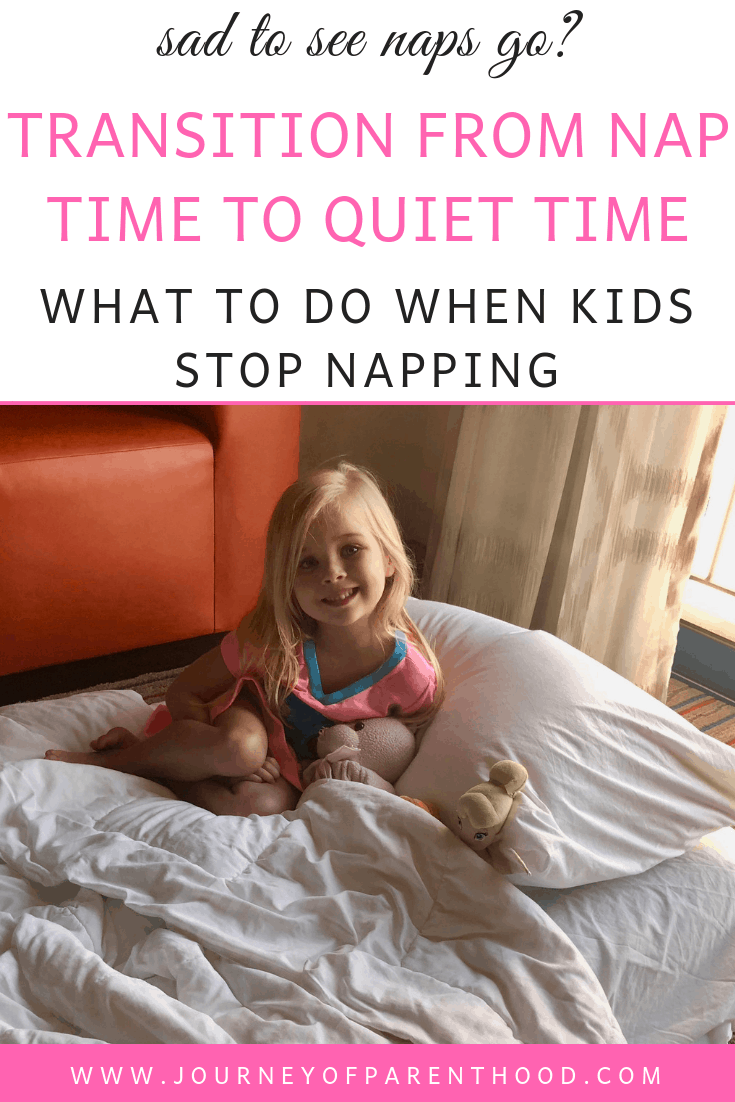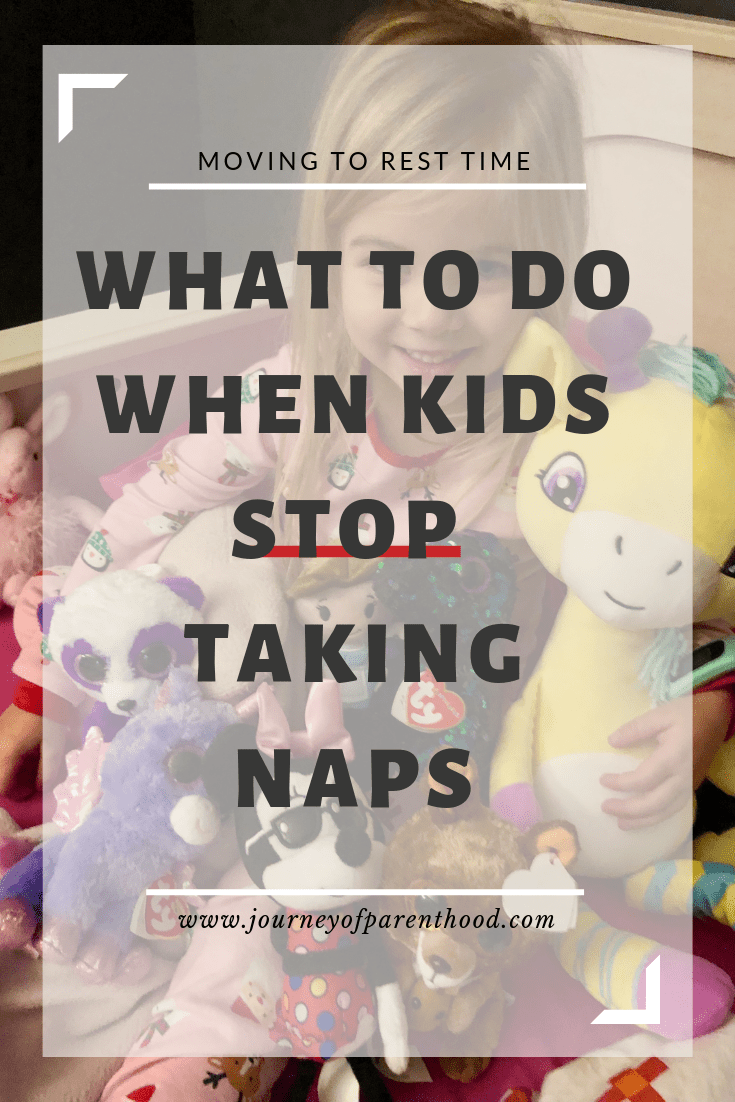Transition from Nap Time to Quiet Time: What to do When Kids Stop Napping.
The day every mother dreads. When our little bit of free time each day appears to be coming to an end. The day a child stops sleeping during nap time.
What do you do when kids stop napping?
You transition from nap time to quiet time! You introduce rest time!
What is rest time?
Rest time is a quiet time period where the goal is to disconnect from the tasks of the day in order to have time to ourselves to relax and feel rejuvenated.

When do Kids Stop Napping?
At some point every child stops sleeping during nap time. This can vary in age and depend on many factors.
In her post she discusses how to tell that your child is done napping:
“Essentially, your child needs to be:
- Old enough (around four years old)
- Capable of being pleasant without a nap
- Not napping most (or even all) days
- Not needing that sleep during the day and can get that sleep at night”
She also answers a very valuable question in her post regarding when do kids stop having rest time or quiet time?
My personal answer? Never. I believe strongly that we ALL need quiet time to ourselves each day. It should be a priority and something we plan for and carve out in our daily schedule.
Having quiet time to ourselves allows us to focus on our relationship with the Lord.
Spend time in prayer. Stop watching the clock. Read a book we enjoy.
Pour into OUR cup so we’re better able to pour into everyone else’s.
How Does Moving from Nap Time to Quiet Time work for Toddlers?
Sometimes children are in a toddler age when they stop sleeping during nap time.
This is the time to transition from nap time to quiet time and to be mindful of establishing rules for rest time with your child.
Allowing for play but containing it to their bed or room with books or other quiet toys is important to keep in mind.
I love that Katrina reminds us that we can’t feel pressure regarding nap time with our children:
“The reality is that we can’t force our children to sleep. We can set them up for success, and provide them guidance and structure.
But at the end of the day, all we can do is put them down for a nap and just cross our fingers that they actually sleep.
The second reality is that children go through phases. Nap strikes happen and it doesn’t mean that naptime isn’t going to be needed again at some point soon.
It simply means that right now, your toddler might be excited about new skills and things they are learning, or maybe are just packed full of energy for some reason.”
We can do all we can do as parents to allow our children to get sleep, but we can’t actually force them to sleep.
When the day comes that naps just aren’t happening then it’s time to transition from nap to quiet time.
Quiet time for toddlers who won’t nap is the perfect solution to ensure they are getting the rest they need each day.
Be sure to read all of Katrina’s awesome rest time rules here!
Why is Making the Transition from Nap Time to Quiet Time important for Preschoolers?
By implementing daily quiet time with our children at an early age we are setting them up for proper self care in their adulthood years!
This daily rest time is especially important during the preschooler age.
It is also a time for a preschooler to learn to play quietly in their room and help avoid sleep issues from sleeping too much during the day and not allowing for quality night time sleep.
She discusses why preschoolers need rest time:
“Preschool-aged children still need a lot of sleep. These kids range from age 3 to 5 and should be getting 10 to 13 hours of sleep at night, and they might need additional daytime sleep.
With busy schedules, kids can end up going to bed later than would be ideal. And in order to get everyone up and where they need to be in the morning they have to wake up earlier too. This makes the finding quiet rest time even more important.
The most important thing is to look at your child’s age and sleep needs, not just what school level they are at.”
It’s easy to see our children growing up and moving up in the school years but it’s so important to always look at their physical age as well as their personal sleep needs when making decisions regarding their schedules.

How does Moving from Nap Time to Quiet Time Work with Older Children?
We all know baby sleep is important.
But often it seems like as kids get older we place less importance on their sleep.
Child sleep matters too! It’s important too! Kids need rest!
Infants nap. Multiple times a day. Toddlers nap. Once a day in the afternoons.
Preschoolers nap on and off. Sometimes they sleep, sometimes they don’t.
What about older kids? Do they still need rest time?
Is quiet time still valuable and what does it look like?
Most older children attend school outside the home so how can rest time work for them?
I share all my thoughts about the importance of rest time for older children here.
“Children have more pressure on them today than ever before. School is exhausting.
More and more often downtime as school is being minimized in order to squeeze in more time for further academics.
Our children have 20 minutes for lunch and 15 minutes for recess! That is barely 30 minutes out of a 7 hour day for any sort of break.
Establishing a consistent rest time allows the child to plan for this time.
A break. A chance to breathe and feel refreshed.
It not only makes a huge difference in their ability to function the rest of the
I am a firm believer in the value of rest time for children and adults alike. I believe we ALL need quality time to ourselves in order to function at our best and to fully enjoy each day.
Be sure to read more on how moving from nap time to quiet time works for older children here!
Conclusion
We are the parent. It is up to us to establish the rules and routines of our home and how our children’s days will be structured.
I hope by visiting the sites mentioned in this post that you have been able to gain helpful tips for transitioning from nap time to quiet time in your home when your children stop napping.
Adding rest time into your daily schedules for kids can benefit the entire family!
Rest Time Post Round Up:
- When Do Kids Stop Napping
- Toddler Refuses to Nap? Implement Rest Time Rules Instead
- Rest Time for Preschoolers: Why It’s So Important
- Rest Time for Older Children
- 10th Birthday Message For My Daughter Love Mom {Tess’s 10th Birthday Letter} - June 12, 2025
- Tips to Maintain Structure While Traveling with Kids - May 22, 2025
- A Letter to my Son on His 16th Birthday From Mom (Kye’s Bday Letter) - April 30, 2025






